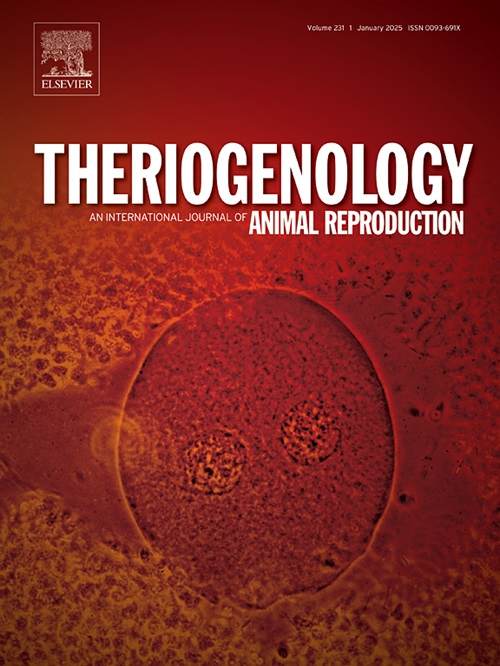用长效重组人卵泡刺激素(corifollitopin - α)刺激Nelore犊牛和青春期前母牛卵巢及随后的取卵和体外胚胎产生结果
IF 2.4
2区 农林科学
Q3 REPRODUCTIVE BIOLOGY
引用次数: 0
摘要
本研究旨在评估使用长效重组人 FSH(rhFSH,corifollitropin-α)诱导奈洛尔种(Bos indicus)犊牛和青春期前小母牛在体外胚胎生产(IVEP)取卵(OPU)前的卵巢刺激。在实验 1 中,进行了一次剂量反应试验,以确定 rhFSH 的最佳剂量,该剂量被确定为 10 μg。在实验 2 中,6-7 月龄的小牛被随机分配到通过 sc(5 头)或 im(5 头)接受 rhFSH。每天通过经直肠超声波检查监测卵泡发育情况,为期五天。途径(P = 0.1348)和途径×时间交互作用(P = 0.8336)对卵泡发育没有影响。实验 3 将 7-8 月龄的犊牛(n = 90)随机分为 5 组:1)对照组:无卵巢刺激;2)rhFSH-96:10 μg rhFSH sc,96 小时后进行 OPU;3)rhFSH-120:10 μg rhFSH sc,120 小时后进行 OPU;4)eCG-96:300 IU eCG im,96 小时后进行 OPU;5)eCG-120:300 IU eCG im,120 小时后进行 OPU。未经 rhFSH 治疗的 Nelore 成熟母牛(n = 10)作为 IVEP 结果的参照对照。与 eCG 或对照组相比(P 0.05),使用 rhFSH 治疗可增加 OPU 在任一时间点(96 或 120 小时)收集的 I 级精母细胞-卵母细胞复合体(COC)的比例。然而,使用 rhFSH 会增加膨胀 COC 的比例,降低存活 COC 的比例(P.05)。本文章由计算机程序翻译,如有差异,请以英文原文为准。
Ovarian stimulation of Nelore calves and prepubertal heifers with a long-acting recombinant human FSH (corifollitropin-alpha) and subsequent ovum pick-up and in vitro embryo production outcomes
The aim of this study was to evaluate the use of a long-acting recombinant human FSH (rhFSH, corifollitropin-alpha) to induce ovarian stimulation in Nelore breed (Bos indicus) calves and prepubertal heifers prior to ovum pick-up (OPU) for in vitro embryo production (IVEP). In Experiment 1, a dose-response trial was performed to determine the optimal dose of rhFSH, which was determined to be 10 μg. In Experiment 2, 6–7 mo old calves were randomly allocated to receive rhFSH either via sc (n = 5) or im (n = 5). Ovarian follicular development was monitored daily by transrectal ultrasonography for five days. There was no effect of route (P = 0.1348) nor route × time interaction (P = 0.8336) on follicle development. In Experiment 3, 7–8 mo old calves (n = 90) were randomly allocated into 5 groups: 1) Control: no ovarian stimulation; 2) rhFSH-96: 10 μg rhFSH sc followed by OPU 96h later; 3) rhFSH-120: 10 μg rhFSH sc and OPU 120h later; 4) eCG-96: 300 IU eCG im and OPU 96h later; and 5) eCG-120: 300 IU eCG im and OPU 120h later. Non-rhFSH treated Nelore mature cows (n = 10) were used as reference-controls for IVEP outcomes. Treatment with rhFSH increased the proportion of grade I cumulus-oocyte complexes (COC) collected by OPU at either timepoints (96 or 120h) compared with eCG or controls (P < 0.0001). Blastocyst rate for rhFSH-120 calves was similar to mature cows (P > 0.05). Treatment with rhFSH, however, increased the proportion of expanded COC and decreased the proportion of viable COC (P < 0.0001) compared with eCG and controls. In Experiment 4, yearling heifers (n = 60) were treated or not (control group) with 10 μg rhFSH sc and OPU was performed 72 or 96h later. Heifers treated with rhFSH had a greater proportion of grade I COC (P = 0.0188) and blastocyst rate (P < 0.0098) than controls, regardless of the interval used. These groups, however, yielded a lesser number of viable COC (P = 0.0264), resulting in a similar (P = 0.5869) number of embryos produced by donor per OPU compared with controls. Pregnancy rate after embryo transfer was also similar between controls and rhFSH groups (19.3 vs 25.0 %, P = 0.4142). In summary, treatment with a single sc injection of corifollitropin-alpha was effective to promote ovarian stimulation in calves prior to OPU. The potential benefits of stimulatory protocols using rhFSH, however, have been overshadowed by a decrease in the total number of viable COC recovered per donor, thus failing to increase the number of embryos produced per OPU.
求助全文
通过发布文献求助,成功后即可免费获取论文全文。
去求助
来源期刊

Theriogenology
农林科学-生殖生物学
CiteScore
5.50
自引率
14.30%
发文量
387
审稿时长
72 days
期刊介绍:
Theriogenology provides an international forum for researchers, clinicians, and industry professionals in animal reproductive biology. This acclaimed journal publishes articles on a wide range of topics in reproductive and developmental biology, of domestic mammal, avian, and aquatic species as well as wild species which are the object of veterinary care in research or conservation programs.
 求助内容:
求助内容: 应助结果提醒方式:
应助结果提醒方式:


